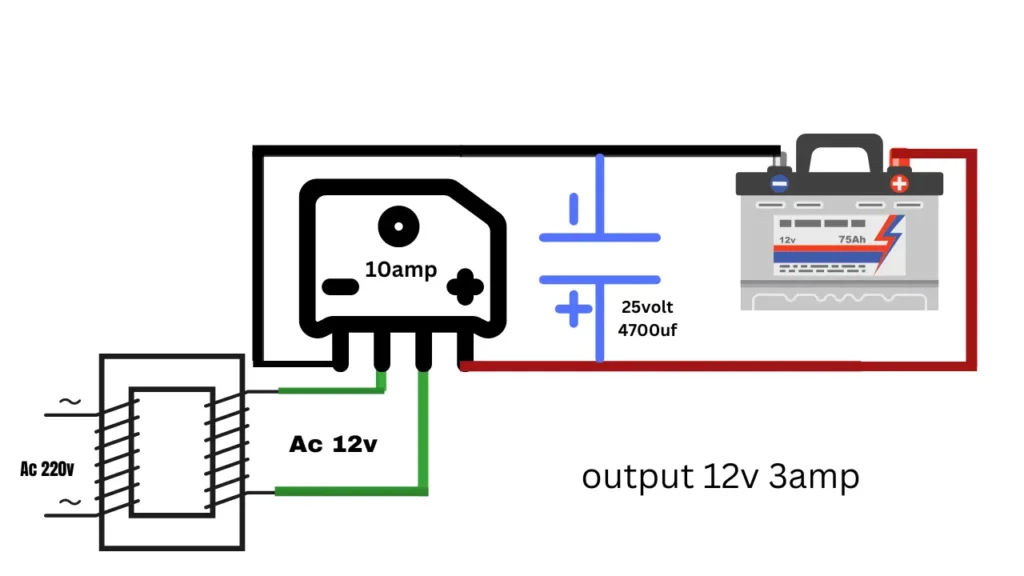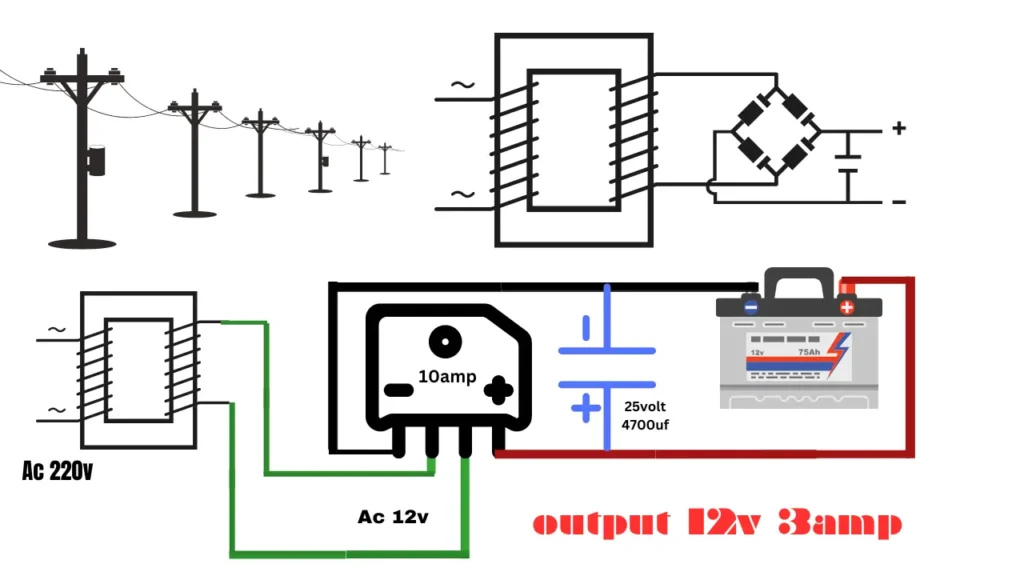Uninterruptible power supplies (UPS), emergency lighting systems, electric vehicles, and other devices frequently employ 12V 7Ah batteries. It is essential to charge the battery properly using the right charger circuit in order to guarantee its longevity and optimum performance.
Understanding the Battery
Let’s quickly review the operation of a 12V, 7Ah battery before moving on to the circuit schematic. Lead-acid batteries, also referred to as valve-regulated lead-acid (VRLA) batteries, are the kind of battery that this is. It has six batteries, each of which produces about 2.1 volts, for a total nominal voltage of 12 volts.
Components Required
To build the 12V 7Ah battery charger circuit, you will need the following components:
- Transformer
- Diodes
- Capacitors
- Resistors
- Voltage Regulator IC
- Relay
- LEDs
- Potentiometer
- Heat sink
- Printed Circuit Board (PCB)
- Connecting wires
- Soldering iron and solder
- Multimeter
Make sure you have these components readily available before proceeding.
Circuit Diagram

Instructions
Let’s now go over the detailed directions for making the 12V 7Ah battery charger circuit:
Safety First
Make sure you have taken the required safety precautions before you begin working with any electronic circuit. Use the required safety equipment, such as gloves and safety glasses, and unplug the power source.
Mounting the Components
Start by adhering to the circuit schematic when installing the components on the PCB. Start with the voltage regulator IC, diodes, capacitors, and resistors.
Transformer Connection
Join the circuit with the transformer. Correct connections between the primary and secondary windings are crucial. For a list of the particular connections, see the circuit diagram.
Relay and LED Connections
Relay and LED connections should be made as shown in the circuit diagram. The battery’s charging and draining will be managed by the relay, while visual cues will be provided by the LEDs.
Potentiometer Adjustment
Setting the desired charging voltage requires adjusting the potentiometer. This voltage needs to fall within the 12V, 7Ah battery’s suggested range.
Heat Sink Installation
To dissipate the extra heat produced during charging, mount a heat sink on the voltage regulator IC.
This will assist in keeping the temperature within acceptable ranges.
Power Connection
Connect the circuit to the power source. To prevent any harm to the battery or charger circuit, make sure your power source is steady and regulated.
Testing and Calibration
Test the circuit thoroughly after all connections have been made. Measure the voltage and current while the battery is charging using a multimeter. To reach the appropriate charging conditions, if necessary, adjust the potentiometer. Battery Charger 12V 7Ah

Enclosure
After successful testing, encase the circuit in a suitable casing to safeguard its operation and shield it from the environment.
Safety Precautions
Keep in mind these safety precautions when working with the 12V 7Ah battery charger circuit:
- Always work in an area with good ventilation.
- Wearing protective gear should include safety goggles and gloves.
- Before connecting anything or making any adjustments, disconnect the power supply.
- To prevent short circuits or improper wiring, double-check the circuit connections.
- Never go above the battery’s recommended charging settings.
- Check the charger circuit frequently for any signs of wear or damage.
Testing and Troubleshooting
Here are some typical troubleshooting hints in case you run into any problems when testing:
- Check all connections for broken or loose wiring.
- Use a multimeter to check the voltages at the input and output.
- Make sure the components are installed and soldered correctly.
- Any components found to be flawed during testing should be replaced.
Maintenance Tips
Consider the following maintenance advice to preserve the durability and best performance of your 12V 7Ah battery charger circuit:
- Dust and dirt should be regularly removed from the circuit.
- Look for any indications of component deterioration or overheating.
- Check the batteries for corrosion and leakage.
- Keep moisture and excessive temperatures away from the charger circuit.
- Observe the manufacturer’s advice on maintenance intervals.
- Also, Read This Article:- Bridge Rectifier Circuit Diagram Download Free 2023.
- Also, Read This Article:- 3.7Volt Li-ion Battery Charger Full Details & solution.
- Also, Read This Article:- How to Make a BLDC Motor ESC Using MOSFET
- Also, Read This Article:– 555 timer ic use throttle or accelerator sensor circuit diagram
- Also, Read This Article:- How to Make a BLDC Motor ESC Using MOSFET
- Also, Read This Article:- 5V PWM Signal Booster Convert 12V PWM Signal Generator
- Also, Read This Article:- How to Make a BLDC Motor ESC Using MOSFET
- Also, Read This Article:- RU6888r Mosfet Datasheet Full Details Download Free
Conclusion
In conclusion, creating a 12V 7Ah battery charger circuit is a simple operation that can be carried out using fundamental electronic knowledge. You may build a dependable and effective battery charger by following the provided step-by-step instructions and circuit schematic. To guarantee the best performance and longevity, keep in mind to emphasize safety and undertake routine maintenance.
FAQ
Can I use a different transformer than the one specified in the circuit diagram?
To guarantee adequate voltage control and effective charging, it is advised to utilize the transformer shown in the circuit diagram.
What should be the ideal charging current for a 12V 7Ah Battery Charger?
A 12V 7Ah battery should be charged at a current of about 700mA. For exact charging guidelines, it is advised to consult the battery manufacturer’s specs.
Can I leave the battery connected to the charger circuit indefinitely?
It is not advised to leave the battery connected to the charger circuit for an extended period of time. Overcharging can shorten the lifespan of batteries and cause battery deterioration.
How can I determine if the battery is fully charged?
The voltage of the battery can be determined with a multimeter. When the battery is fully charged, the voltage ought to level off within the suggested range (around 14.4 volts for a 12V battery).
Is it possible to modify the circuit for charging multiple batteries simultaneously?
Yes, the circuit can be changed to charge numerous batteries at once. But other factors, such appropriate current distribution and voltage management, would.